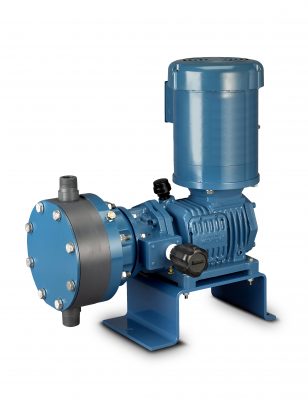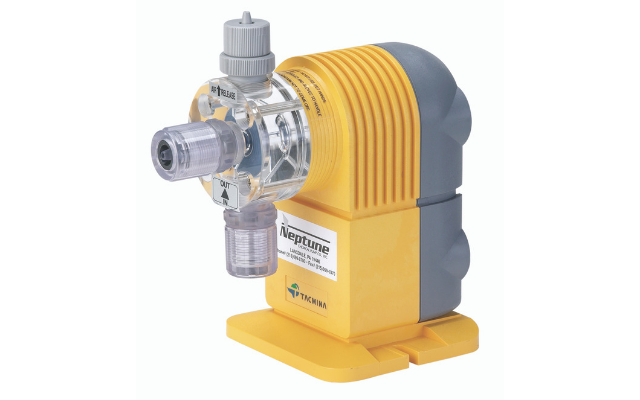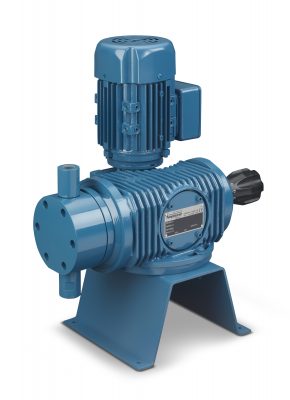Mechanically actuated diaphragm metering pumps can satisfy all operational requirements, especially those relating to the mitigation of the harmful effects of off-gassing
Author: Tom O’Donnell
The use of sodium hypochlorite (which has the chemical formula NaOCI or NaCIO) – known as liquid bleach to the general public – is common in many industrial applications. The list of its uses includes bleaching, cleaning, disinfecting, deodorizing and water treatment, all of which can be daily applications in an industrial-manufacturing setting. The list of industries in which sodium hypochlorite is often used is also a long and diverse one – agriculture, chemical, paint and coatings, lime, food and beverage, glass, pulp and paper, pharmaceutical, synthetics and HVAC/R.
But while to most people sodium hypochlorite is simply a consumer product that can be purchased off-the-shelf at the local grocery store, the companies that manufacture and use it for industrial purposes are well aware of the dangers that can be associated with its production and handling.
 Confronting Off-Gassing Challenges
Confronting Off-Gassing Challenges
Sodium hypochlorite is an oxidizer whose oxidation reactions can be extremely corrosive. When used in concentrated forms, the solution – if handled improperly – can burn exposed skin and cause severe eye damage. Also, when sodium hypochlorite solutions come in contact with some metals flammable hydrogen gas may be created. If these containers are heated, they may explode due to the buildup and release of chlorine gas.
From a production standpoint, the main challenge in handling sodium hypochlorite is overcoming its tendency to “off gas” when it is being pumped or metered. Off-gassing occurs when the sodium hypochlorite begins to decompose in a storage tank or transfer pipe. When sodium hypochlorite decomposition occurs – which happens at an accelerated rate in higher pH concentrations and at elevated ambient temperatures – it transforms into a salt solution that generates oxygen bubbles. As the oxygen bubbles accumulate in the pumping or metering system’s suction lines, they can cause a loss of prime, which will inhibit the effectiveness of the pumping or metering process.
Therefore, any industrial-manufacturing operation that uses large amounts of highly concentrated sodium hypochlorite must identify and utilize pumps that will not be susceptible to off-gassing, which can result in negative effects that can hamper the overall production process.
In general, facility managers who must optimize the metering of sodium hypochlorite in their production processes should take into account six considerations before choosing a metering pump. They are:
- Always use a high-stroking pump model with a short stroke length. This operational configuration is less likely to permit the accumulation of gas in the pump head, which will lead to a lower risk that off-gassing will occur and result in optimized performance.
- If the operation requires the pumps to be idle for an extended period of time, gas can build up in the suction lines and pump head. In these conditions, it is recommended that the pump be outfitted with a bypass line that features an automated valve so that the sodium hypochlorite can be recirculated when it is not being actively fed by the pump.
- The production area should be constructed in a way that the tank that is used to store the sodium hypochlorite is not located in direct sunlight. The higher ambient temperatures that can be created by direct sunlight will increase the sodium hypochlorite’s off-gassing rate.
- Much like it’s not wise to oversize pumps, any application that requires sodium hypochlorite should use it in a concentration that is just necessary to complete the process. Higher-than-needed concentrations will increase the rate of off-gassing. The proper concentration should also be combined with a metering pump featuring a straight-through head design so that no gas can nest and bind the pump. This will also reduce the rate of off-gassing.
- When configuring the pumping system, a short, flooded suction-pipe arrangement with the suction piping traveling down from the storage tank to the metering pump is most effective. This design allows any gas bubbles that are produced to flow back to the storage tank, rather than into the pump. This also means that the metering pump should not be mounted on top of the storage tank, unless the pH level of the sodium hypochlorite is very low.
- If the setup allows, an air vent should be used to purge the valve in the head of the metering pump. Purging the pump head will enable any trapped sodium hypochlorite to be evacuated, which will prevent it from reaching the pump head.
In reviewing these considerations, it becomes apparent that the best type of pump to use in sodium hypochlorite service – especially when limiting the harmful effects that off-gassing can have while providing exceedingly accurate metering rates –is the mechanically actuated diaphragm pumps (electronic or motor-driven).
This pump technology excels in sodium hypochlorite applications because the piston in the pump is attached to the diaphragm with the forward (positive) movement of the piston ensuring positive diaphragm return, which optimizes the pump’s suction capabilities. More specifically, the best choices for sodium hypochlorite handling metering pumps that have a high stroking speed (300 strokes per minute) and short stroke length, which makes it less likely that gas will accumulate in the pump head. In addition, these pumps can be outfitted with an automatic vent valve that allows any trapped gas to be purged from the pump head. Most models of this nature are also offered with manual control, automatic control or fully programmable control features that allow them to produce flow rates of up to 20 gallons per hour (76 L/hr).
Motor-driven diaphragm metering pumps feature a straight-through flow path, which effectively eliminates any areas within the pump head where gas can nest or lodge. The pumps are self-priming, available in capacities to 300 gph (1,135 L/hr), and can be provided with automatic frequency control. A micrometer dial can adjust the pump’s capacity up to a 10:1 turndown ratio while it is running. Depending on the needs of the specific application, the pumps can be available in PVC and Kynar® materials of construction—which are ideal for sodium hypochlorite service—and all parts within the gearbox are submerged in oil for extended service life.
Conclusion
Sodium hypochlorite is one of the most versatile bleaching, cleaning, deodorizing and disinfecting compounds available to industrial manufacturers. This versatility is what makes it an ever-present fluid in manufacturing facilities around the globe. However, while its advantages are myriad, sodium hypochlorite must be handled carefully, especially when used in higher concentrations. Aside form the dangers it can pose to humans and the environment if it is mishandled, sodium hypochlorite has handling characteristics that must be acknowledged and addressed if the facility operators are to optimize their sodium hypochlorite-handling applications.
The overriding operational concern is sodium hypochlorite’s propensity to off-gas, particularly when it is used in solutions with higher pH levels and at elevated temperatures. If the harmful effects that off-gassing can have are not taken into consideration before a metering pump is selected, the result could be an operation that will face excessive downtime caused by pump malfunctions that can lead to expensive repair or replacement. By addressing the six considerations that are the backbone of pump selection for sodium hypochlorite service, the operator will come to the conclusion that mechanically actuated diaphragm metering pumps are the best choice for the application.
About the author:
Tom O’Donnell is Director of Business Development for Neptune™ and PSG®. He can be reached at (215) 962-2956 or Tom.ODonnell@psgdover.com. Based in Grand Terrace, CA, USA, Neptune Chemical Pump Co., is a leading manufacturer of chemical metering and peristaltic (hose) pumps, chemical feed systems, chemical injection accessories, polymer makedown systems and portable mixers. Neptune is an operating company within PSG, Oakbrook Terrace, IL, USA, a Dover company. PSG is comprised of several leading pump companies, including Abaque®, Almatec®, Blackmer®, Ebsray®, EnviroGear®, Griswold™, Mouvex®, Neptune™, Quattroflow™, RedScrew™ and Wilden®. You can find more information on Neptune at www.neptune1.com and PSG at www.psgdover.com.






Comments